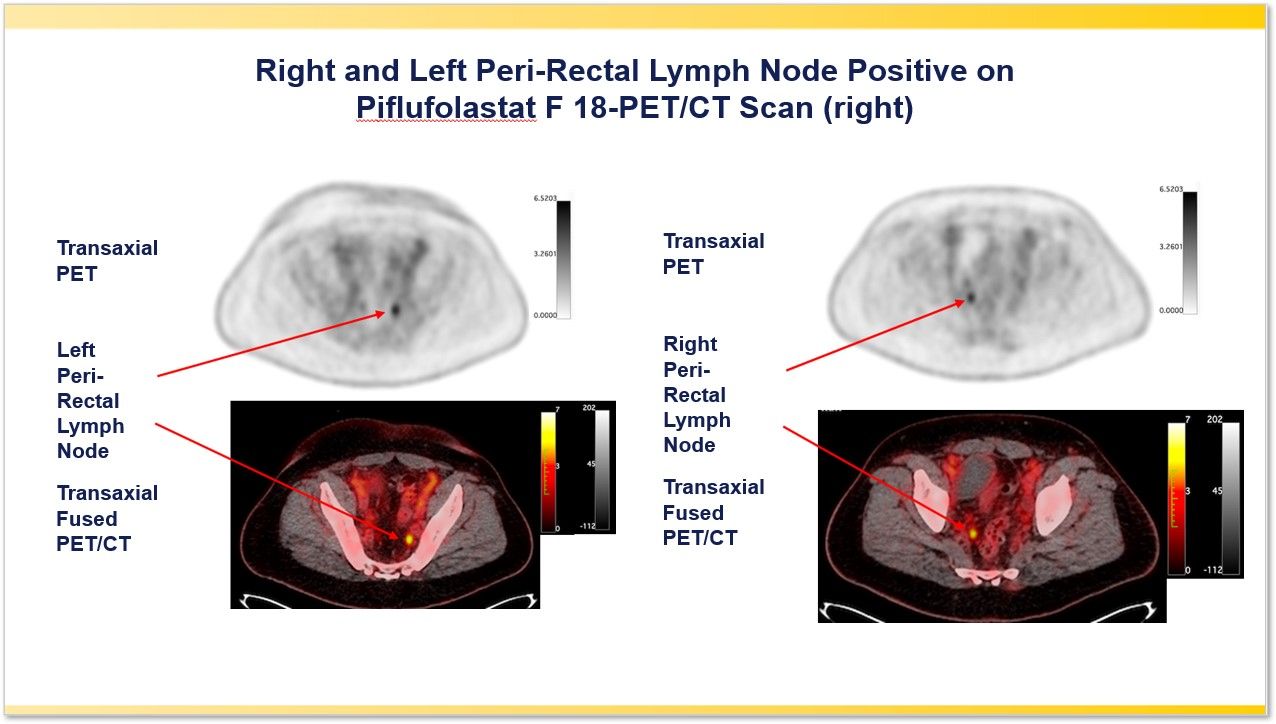Radiotracer Identifies Metastatic Prostate Cancer Regardless of Anatomic Region
Recently approved PMSA-targeted radiotracer can pinpoint biochemical recurrent prostate cancer in men with unhelpful standard imaging.
Radiotracer 18F-DCFPyL, used with PET imaging, can detect and localize recurrent prostate cancer, according to new research results.
In a phase III clinical trial, this radiotracer was able to bind selectively to prostate-specific membrane antigen (PMSA) with high affinity and identify metastatic lesions no matter the anatomic region with high positive predictive value (PPV), further indicating that PMSA-targeted radiotracers are useful in prostate cancer imaging. 18F-DCFPyL was approved by the U.S. Food & Drug Administration in May, and the trial outcomes were presented during the Society of Nuclear Medicine and Molecular Imaging 2021 Annual Meeting.
For more SNMMI 2021 coverage, click here.
In a 14-site prospective study across the United States and Canada, researchers from Johns Hopkins University examined both the PPV and detection rate of PET/CT with the radiotracer by anatomic region –specifically prostate/prostate bed, pelvic lymph nodes, and regions outside the pelvis. For the study, they included men with rising prostate-specific antigen (PSA) levels post-local therapy and negative or equivocal conventional imaging results.
Case example: A 54-year-old man with a history of RP+LND and a subsequent PSA of 1.25 ng/mL had no evidence of disease by baseline imaging. Piflufolastat F 18 (18F-DCFPyL)- PET/CT accurately detected biochemically recurrent prostate cancer with the PSMA PET/CT scan identifying positive left (left panel) and right peri-rectal lymph nodes (right panel).
Credit: Steven Rowe, M.D., Ph.D., Johns Hopkins University

For the study, the team, led by Steven Rowe, M.D., Ph.D., associate professor of radiology and radiological science, imaged patients with 18F-DCFPyL at the start of the study and, again, after 60 days to verify suspected lesions using a composite “standard of truth” that included histopathology, correlative imaging findings, and PSA response. They, then, compared the radiotracer imaging to the “standard” to determine the PPV and detection rate.
Based on their analysis, the team determined 18F-DCFPyL-PET/CT effectively detected and pinpointed metastatic lesions with high PPV no matter the location for men who had biochemically recurrent prostate cancer and standard imaging that was uninformative.
Specifically, the median detection rates for prostate and prostate bed, lymph nodes, and extra-pelvic region were 20.2 percent, 35.1 percent, and 26.4 percent, respectively. In addition, the median PPV for the anatomic regions was 79.5 percent, 70.9 percent, and 67.4 percent, respectively. The extra-pelvic lymph node and bone PPVs compared to soft tissue regions, the team said.
With these results – and with these agents becoming more widely available -- Rowe said, patients who have newly diagnosed, recurrent, metastatic prostate cancer could soon have additional therapy options.
For more coverage based on industry expert insights and research, subscribe to the Diagnostic Imaging e-Newsletter here.
Study with CT Data Suggests Women with PE Have More Than Triple the One-Year Mortality Rate than Men
April 3rd 2025After a multivariable assessment including age and comorbidities, women with pulmonary embolism (PE) had a 48 percent higher risk of one-year mortality than men with PE, according to a new study involving over 33,000 patients.
The Reading Room: Racial and Ethnic Minorities, Cancer Screenings, and COVID-19
November 3rd 2020In this podcast episode, Dr. Shalom Kalnicki, from Montefiore and Albert Einstein College of Medicine, discusses the disparities minority patients face with cancer screenings and what can be done to increase access during the pandemic.
Predicting Diabetes on CT Scans: What New Research Reveals with Pancreatic Imaging Biomarkers
March 25th 2025Attenuation-based biomarkers on computed tomography (CT) scans demonstrated a 93 percent interclass correlation coefficient (ICC) agreement across three pancreatic segmentation algorithms for predicting diabetes, according to a study involving over 9,700 patients.
Can Photon-Counting CT be an Alternative to MRI for Assessing Liver Fat Fraction?
March 21st 2025Photon-counting CT fat fraction evaluation offered a maximum sensitivity of 81 percent for detecting steatosis and had a 91 percent ICC agreement with MRI proton density fat fraction assessment, according to new prospective research.